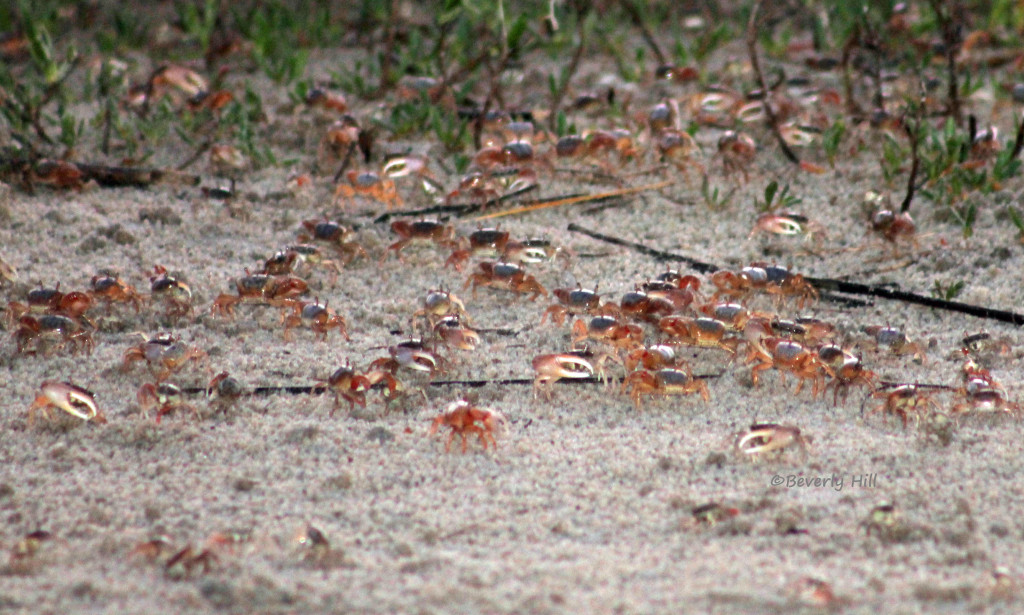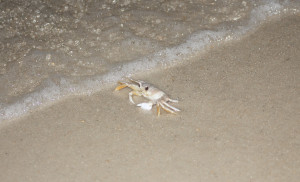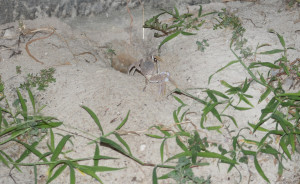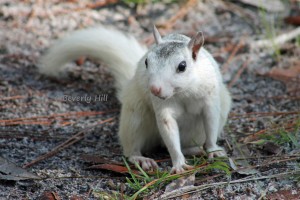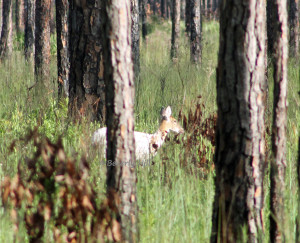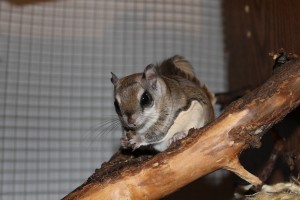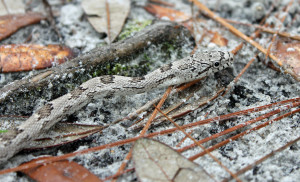Many people visit state parks for access to amenities such as beaches, boating, fishing, sunbathing, hiking and camping, but within a state park one can find so much more if they seek it out.
Fiddler Crabs
Fiddler crabs are an amazing spectacle most easily found on mud flats during the falling tide. Hundreds, sometimes thousands, of these tiny creatures can be seen moving in mass before a visitor’s approach as they attempt to flee back into their tiny burrows or into the grass line. If one stands still, they will hesitantly reemerge and go about their business of feeding on the detritus lining the flats. Closer observation may reveal tiny clicking noises, and sometimes they can be seen waving their over-sized dominant claw in challenge of, or in courtship with, other crabs.
These small crabs perform a valuable service by aerating the soil and shuffling organic substances to the surface. They are also a valuable food source to a variety of birds and coastal mammals that hunt the shoreline looking for sustenance of their own. If you happen to find yourself in the presence of these small but mighty crabs, take a moment to acknowledge and observe them as they go about their day on the marsh.
Ghost Crabs
Ghost crabs are another fascinating crab found more often on the ocean or gulf side of the coastal habitat. These light colored, nearly translucent crabs are more easily found at night, coming out of the golf ball-sized openings of their burrows and scurrying off at speeds up to 10 mph to hunt. With their coloration and speed, it’s easy to see why they are called ghosts. These crabs have 360º vision and are nearly impossible to catch. These special characteristics also help them when hunting their prey which ranges from other crabs, clams, stranded fish, baby sea turtles and even vegetation.
They prefer to build their burrows above the high water line, sometimes up to ¼ mile from the shoreline, tunneling out a chamber that can be as much as 4′ deep ending in a widened chamber with a small pool of water inside. Although they are very poor swimmers and can drown, they do have to wet their gills and eggs frequently.
White Squirrels and White Deer of Ochlockonee River State Park
These amazing squirrels are actually a color variant of the gray squirrels that also share the park. There are many stories about their origins, but most likely they are simply the result of recessive genes coming to the forefront in a particular squirrel cluster. Nevertheless, they relish being the stars of Ochlockonee and can often be seen approaching campers and picnickers begging for a handout. On my most recent camping trip I even had to shoo one out of the camper after he’d come inside to help himself.
White squirrels aren’t the only white resident at Ochlockonee. There is a small herd of piebald, whitetail deer that includes at least one doe that is almost completely white. These deer are most easily seen in the early morning hours and near dusk, but I also had luck finding them while hiking a nature trail and stopping frequently just to observe and listen. They are masters at concealing themselves among the abundant Saw palmettos in the park.
Southern Flying Squirrels
These tiny nocturnal squirrels are seldom seen, instead preferring to glide quietly from treetop to treetop, mainly in hardwood forests in the night. If one listens carefully you can sometimes hear their chirps and clicks from high up in the canopy. These tiny squirrels also have a secret language to themselves inaudible to the human ear. A researcher, Michelle Gillie at Auburn University, discovered that Flying squirrels are able to communicate in the sonic and ultrasonic range, thereby making these gliding mammals even more amazing.
My first encounter with a Southern Flying squirrel was at Torreya State Park and I’ve been fascinated by them ever since. If you’re ever at Torreya State Park, take a stroll up to the old Gregory House after dark and have a seat on the porch and listen to the sounds of the night.
Snakes
Although not everyone’s favorite, I enjoy finding snakes. Sometimes I’ll get lucky enough to find a seldom seen species such as the Marsh snake at St. Joseph Peninsula State Park, but usually during my travels it’s something more common like a Black racer, Rat snake or even a venomous Cottonmouth. Snakes aren’t evil as some would have you think. Most actually perform a valuable service in keeping rodent populations in check. There are those that eat birds and their eggs, other snakes, lizards, and various small animals, but overall I consider snakes a positive resource. They, in turn, provide food for other animals such as birds, raccoons, fox, coyote and other predators. If you’re nervous around snakes, simply give them their space.
So the next time you’re at a Florida State Park, try to appreciate it from a new perspective. Slow down and look around more carefully. You may be pleasantly surprised with what you find.
[amazon template=iframe image&asin=1583553029]

